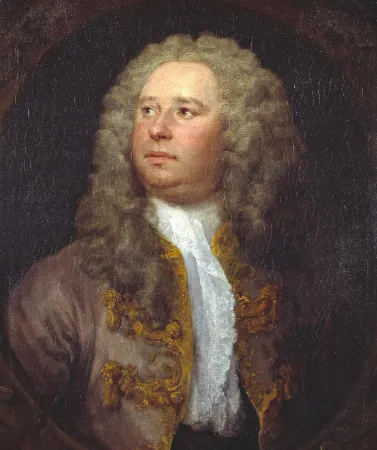
This picture, one of Hogarth's most successful bust-length male portraits, depicts the actor James Quin (1693-1766). Quin's pose is deliberately theatrical, his head turned to the right, his eyes raised upwards as if in search of divine inspiration. The figure is framed within a feigned, carved stone roundel. Quin's expressive countenance accentuated by the inventive way in which Hogarth has painted his long wig, the right side cascading down his coat, while the left is swept back behind the shoulder. Indeed, the whole ensemble reveals a conscious debt to the conventions of the Baroque. 'The full-bottom wig, like the lion's mane, hath something noble in it', wrote Hogarth, 'but were it to be worn as large again it would become a burlesque' (1997, p.31). Quin's clothing too proclaims his sense of importance, his fine ruffles of Flemish lace and his brown velvet coat heavily trimmed with elaborate gold 'frogging'. The whole portrait has an air of archaic splendour, befitting one who was, by the late 1730s, the mainstay of an increasingly outmoded and bombastic school of acting.
James Quin was born in Covent Garden, the illegitimate son of an Irish barrister. By 1716 he was an established figure on the London stage, while his characterization of Falstaff in 1720 confirmed his position as one of the capital's leading actors. Hogarth, who had many friends in the acting profession, was a close friend of Quin, the two men belonging to the same masonic lodge. Quin loved company and was cherished for his wit and generosity. Like Hogarth he was short and increasingly rotund, owing to his renowned gluttony. He also possessed a fiery temperament; it was rumoured that he had killed two of his fellow-actors in duels. Quin continued to act until his retirement in 1751, by which time he had been eclipsed by the brilliance of David Garrick, whose lively, naturalistic acting was in sharp contrast to Quin's static, declamatory manner. Even so, the men became good friends during Quin's long retirement, Garrick penning the epitaph for Quin's tomb in Bath Abbey.
Further reading:
Elizabeth Einberg, Hogarth the Painter, exhibition catalogue, Tate Gallery 1997, p.31, no.10, reproduced in colour
Elizabeth Einberg and Judy Egerton, The Age of Hogarth. British Painters born 1675-1709, Tate Gallery 1988, pp.98-9, reproduced in colour
Martin Postle
August 2000